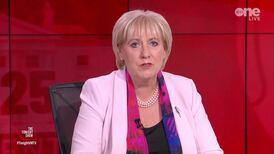Economic analysis:Fianna Fáil's economic policy is based on confident predictions but is it realistic, asks Marc Coleman, Economics Editor
When making an assessment about anything it's always nice to start with some praise. Fianna Fáil's economic plan The Next Steps Forward, which it published yesterday, deserves full marks for completeness.
Neither this nor any recent election has seen a party come out with such a thorough set of economic projections to underpin its promises.
Hopefully when they produce their proposals on Thursday, Fine Gael and Labour will be as thorough. Now the pleasantries have been dispensed with, the real question must be asked: are Fianna Fáil's plans realistic?
Economic growth delivers tax revenues and for that reason the realism of any forecast is the rock upon which any party seeking re-election must found its election platform. By the end of March most political parties had come out with initial proposals on taxation, proposals that assumed a growth rate of about 4.5 per cent over this period. Until the end of March, that assumption was a reasonable one.
But just as a week is a long time in politics, a fortnight is a long time in economics. It's a little over two weeks since both the Central Statistics Office (CSO) and Davy stockbrokers came out with two forecasts that - if they materialise - will present Fianna Fáil with some tough choices if re-elected. The ESRI predicts that growth will fall to 3.9 per cent next year, while Davy predict growth will fall to 3 per cent.
Fianna Fáil's persistence yesterday that the economy will continue to grow by 4.5 per cent in real terms - ie excluding inflation - is confident, if not brave. Another brave assumption is that tax revenue growth will over the lifetime of the next government be 1.1 times the rate of growth in nominal Gross Domestic Product (GDP). Nominal GDP is the value of goods and services produced in the economy each year and its growth rate results from growth in real GDP, the quantity of goods and services produced and the rate of price rises.
If Fianna Fáil dreams come true, nominal GDP will rise by 7 per cent and tax revenues by 7.7 per cent every year they are in power. From their present level of €49.7 billion this year, tax revenues will rise to €71.9 billion by the year 2012, giving a bonanza of €22 billion to implement the National Development Plan, on generous tax cuts and a host of commitments on spending.
If things go well, Fianna Fáil will be able to raise the pension to €300, hire thousands of extra gardaí, teachers and hospital consultants, index tax bands and double the home carer's allowance. Despite this, its worst fiscal performance would still be a surplus in 2012 of 0.2 per cent of GDP, comfortably within Stability Pact limits.
But supposing things don't go well? There are several good reasons why more prudent growth assumptions are warranted. Certainly, Davy's forecasts are on the pessimistic side. More recently NCB stockbrokers predicted that the rate of growth would be 4.5 per cent next year and slightly higher thereafter. Sitting between Davy's and NCB's forecasts are those of the the ESRI. In its latest quarterly economic commentary the institute predicts growth of 3.9 per cent. That commentary strongly warns that the economy's competitiveness is deteriorating. It also points to evidence that the mainstay of recent growth, the property market, is starting to decline. Even the latest exchequer returns have shown that after years of overshoot, government tax revenue growth may start to come in below target soon after the election.
At the very least, it would seem prudent to stress test Fianna Fáil's assumptions. If we assumed that ESRI is right and that competitiveness continues to deteriorate and the property market continues slowing, we might pencil in a figure of 3.5 per cent for average real growth between 2008 and 2012.
We might also make a modest reduction in the expectation for tax buoyancy. Instead of growing at 1.1 times the rate of nominal GDP growth, revenue growth might only match nominal GDP growth. This is because - as a factor which has produced most of the bounce in revenues recently - the property market has had its day.
To call this a "worst case" scenario could even be optimistic. If Irish real GDP growth decided to converge with the euro zone average rate for last year of 2.6 per cent, the government would be facing a choice of implementing its programme or breaching the Stability Pact. And even that assumes that Fianna Fáil can face down growing demands for another round of benchmarking style pay increases for the public sector, and in doing so keep spending growth to about 7 per cent a year.
But let's give Fianna Fáil the benefit of the doubt and stick with 3.5 per cent growth. In that scenario tax revenues will rise to just under €66 billion, €5 billion lower than Fianna Fáil forecasts. That will present the party with a dilemma. Based on crude arithmetic, Fianna Fáil plans to give away €9 billion in tax cuts and indexation between 2008 and 2012.
It plans to raise spending by €7.4 billion. Brian Cowen yesterday refused to say which of these priorities would be sacrificed in the event the economy underperforms. With signs of economic slowdown increasing with every week, one thing is clear: if Fianna Fáil, or any party, wishes to be taken seriously by the electorate, it must state clearly which of its promises will have priority in the event of a squeeze.








